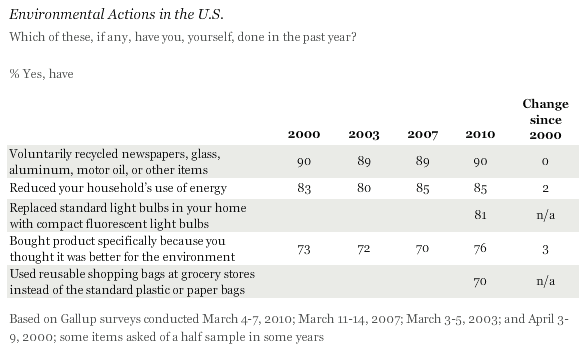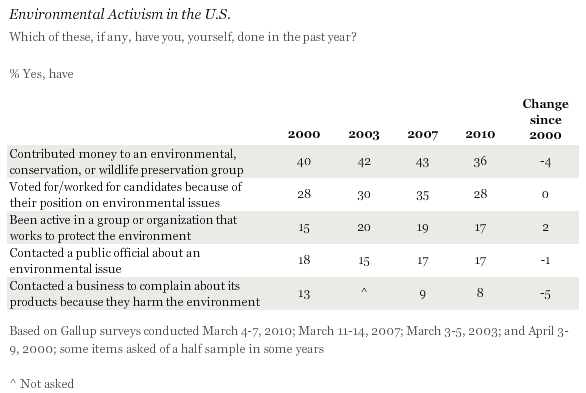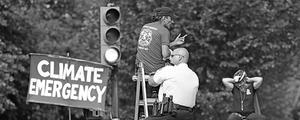WASHINGTON, D.C. -- Americans are today no more environmentally friendly in their actions than they were at the turn of the century. While more than three in four recycle, have reduced household energy use, and buy environmentally friendly products, these numbers have barely budged since 2000.

Americans in 2010 remain more likely to recycle newspapers, glass, aluminum, motor oil, or other items than to undertake any of the other environmentally friendly actions Gallup tests -- with 9 in 10 saying they do so. Gallup asked about replacing standard light bulbs with compact fluorescent light bulbs and using reusable shopping bags for the first time this year, and it found Americans about as likely to take these actions as they are to take other steps, such as reducing household energy consumption and buying more environmentally friendly products.
The stability of these findings stands in juxtaposition to the political and media attention paid to global warming and climate change over the past decade, particularly since Al Gore's 2006 documentary "An Inconvenient Truth." Gallup also finds Americans no more worried about the threat posed by global warming than they were at the start of the decade and that very few Americans name the environment as the most important problem facing the country. In fact, Gallup recently found Americans' level of concern about many environmental problems at a 20-year low, and environmental quality ratings rebounding to where they were at the start of the decade.
Those who perceive a serious threat from global warming in their lifetimes are often not any more likely to take environmentally friendly steps than are those not perceiving a global warming threat. Only in the case of buying more environmentally friendly products or using reusable shopping bags is there a meaningful difference. There are also few noteworthy differences by age, income, or party identification.
Environmental Activism Also Steady
Americans are also no more likely now than in the past to engage in activist behavior to promote environmentally friendly actions by organizations, politicians, or companies. Far less than half report engaging in any such actions, and again, those numbers have hardly changed over the past decade.

Given that Americans name the environment as the least important of seven major issues to their vote for Congress, it is improbable that environmental activism will increase by any significant degree this election year. Such behavior is, however, more likely among those who view global warming as a serious threat in their lifetimes.
Implications
While most Americans continue to voluntarily take steps to help the environment, the likelihood that an individual will do so appears fairly fixed and largely unaffected by outside influences or even one's own demographics. Stated more simply, those who are willing to undertake such measures are probably already doing so, while others may never be willing to do so.
The entrenched nature of these findings suggests that those who seek to encourage even more environmentally friendly behaviors from the overall population have their work cut out for them, especially if the actions remain voluntary. It is possible that in these matters, only tangible incentives will inspire further action, such as the 5-cent bag tax recently levied in Washington, D.C., which cut plastic bag usage from 22.5 million to 3 million in its first month in effect. Still, policymakers should be mindful that with many Americans already voluntarily taking steps to help the environment and with the issue ranking very low on Americans' overall policy priority list, such initiatives could be a tough sell.
Survey Methods
Results are based on telephone interviews with a random sample of 1,014 national adults, aged 18 and older, conducted March 4-7, 2010. For results based on the total sample of national adults, one can say with 95% confidence that the maximum margin of sampling error is ±4 percentage points. For results based on the half sample of 519 national adults in Form A and 495 national adults in Form B, the maximum margins of sampling error are ±5 percentage points.
Interviews are conducted with respondents on landline telephones (for respondents with a landline telephone) and cellular phones (for respondents who are cell phone only).
In addition to sampling error, question wording and practical difficulties in conducting surveys can introduce error or bias into the findings of public opinion polls.
